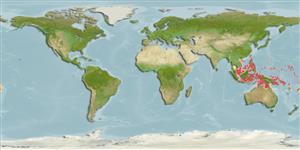Teleostei (teleosts) >
Perciformes/Uranoscopoidei (Sand dwellers) >
Pinguipedidae (Sandperches)
Etymology: Parapercis: Greek, para = the side of + Greek, perke = perch (Ref. 45335); sagma: Name from Greek meaning saddle; referring to the pattern of dark saddles on the back.
Environment: milieu / climate zone / depth range / distribution range
Ecology
Marine; reef-associated; depth range 55 - 80 m (Ref. 90102). Tropical
Western Pacific: Indonesia and Vanuatu.
Size / Weight / Age
Maturity: Lm ? range ? - ? cm
Max length : 7.2 cm SL male/unsexed; (Ref. 90102)
Short description
Identification keys | Morphology | Morphometrics
Found solitary in sand-rubble bottoms with scattered rock and coral outcrops near reefs in 55-80 m (Ref. 90102).
Life cycle and mating behavior
Maturity | Reproduction | Spawning | Eggs | Fecundity | Larvae
Allen, G.R. and M.V. Erdmann, 2012. Reef fishes of the East Indies. Perth, Australia: Universitiy of Hawai'i Press, Volumes I-III. Tropical Reef Research. (Ref. 90102)
IUCN Red List Status (Ref. 130435: Version 2024-1)
Threat to humans
Harmless
Human uses
Tools
Special reports
Download XML
Internet sources
Estimates based on models
Preferred temperature (Ref.
123201): 26.5 - 28.3, mean 27.2 °C (based on 42 cells).
Phylogenetic diversity index (Ref.
82804): PD
50 = 0.5000 [Uniqueness, from 0.5 = low to 2.0 = high].
Bayesian length-weight: a=0.00692 (0.00314 - 0.01524), b=3.06 (2.88 - 3.24), in cm total length, based on LWR estimates for this Genus-body shape (Ref.
93245).
Trophic level (Ref.
69278): 3.3 ±0.4 se; based on size and trophs of closest relatives
Resilience (Ref.
120179): High, minimum population doubling time less than 15 months (Preliminary K or Fecundity.).
Fishing Vulnerability (Ref.
59153): Low vulnerability (10 of 100).
